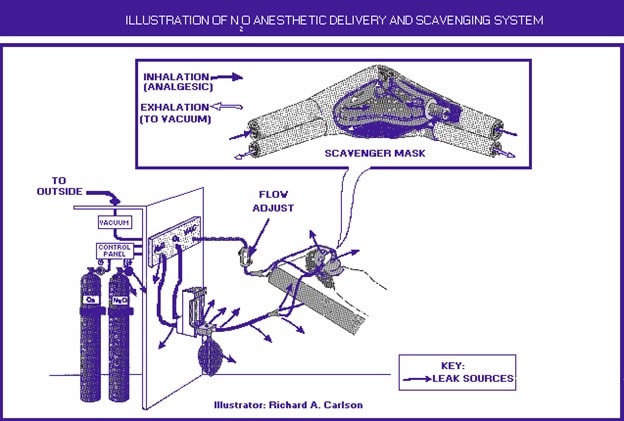Engineering Controls Database
Dental Operatories – Control of Nitrous Oxide
|
Nitrous oxide (N2O) is an anesthetic agent used in dental operating rooms. Workers are exposed to N2O while administering anesthetic gas to patients. To protect workers from the health risks associated with N2O, operating rooms are often equipped with scavenging systems that vent unused and exhaled gas away from the work area. Research shows that these systems can significantly reduce the risk of impaired fertility among female dental assistants exposed to N2O [Rowland et al.1992]. However, a National Institute for Occupational Safety and Health (NIOSH) Alert [NIOSH 1994] reports that even with scavenging systems in place, NIOSH researchers measured N2O exposures more than 40 times the NIOSH recommended limit in dental operating rooms. The report clearly demonstrates that simply using a system is not sufficient--it must be continuously monitored and maintained to effectively reduce exposure to N2O. |
|
| Several studies of workers have shown that occupational exposure to N2O causes adverse effects such as reduced fertility [Rowland et al. 1992], spontaneous abortions, and neurologic, renal, and liver disease [Cohen et al. 1980]. A previous study [Rowland et al. 1992] reported that female dental assistants exposed to unscavenged N2O for 5 or more hours per week had a significant risk of reduced fertility compared with unexposed female dental assistants. The exposed assistants had a 59% decrease in probability of conception for any given menstrual cycle compared with the unexposed assistants. For dental assistants who used scavenging systems during N2O administration, the probability of conception was not significantly different from that of the unexposed assistants. Since environmental exposures were not measured during these epidemiologic studies, no dose-effect relationship could be established. | |
|
NIOSH research has shown controls including System Maintenance, Ventilation and Work Practices can effectively reduce N2O concentrations in dental operations to approximately 25 ppm during analgesia administration, the exposure limit recommended by NIOSH. Uncontrolled exposures to N2O have exceeded 1000 ppm. Three controls are recommended: SYSTEM MAINTENANCE Inspect and maintain the anesthetic delivery system to prevent N2O leaks in all hoses, connections, fittings. Repair all leaks immediately (Figure 1).  VENTILATION • Scavenging System-- Use Scavenging. Exhaust ventilation of N2O from the patient's mask should be maintained at an air flow rate of 45 LPM, measured by a calibrated flow device, and vented outdoors -- not into the room ventilation system. • Room Ventilation-- Where possible, use 100% clean outdoor air for dental operatory ventilation. Supply and exhaust vents should be separated by at least 15 feet to allow good mixing and prevent "short-circuiting." (ASHRAE Std 62-2001) • Auxiliary Exhaust Ventilation-- Local exhaust hood should be placed near the patient's mouth to capture excess N2O from breathing. WORK PRACTICES • Select scavenging masks of proper sizes to fit patients. • Prudent use of N2O to appropriately sedate patients is encouraged. • Monitor the air concentration of N2O to insure controls are effective in achieving low levels during dental operations. |
|
| 166-12B; | |
|
Cohen EN, Gift HC, Brown BW, Greenfield W, Wu ML, Jones TW, et al. [1980]. Occupational disease in dentistry and chronic exposure to trace anesthetic gases. J Am Dent Assoc 101(1):21B31. McGlothlin JD, Jensen PA, Cooper TC, Fischbach TJ, Fairfield CL [1990]. In-depth survey report: control of anesthetic gases in dental operatories at University of California at San Francisco Oral Surgical Dental Clinic, San Francisco, CA. Cincinnati, OH: U.S. Department of Health and Human Services, Centers for Disease Control, National Institute for Occupational Safety and Health, Report No. ECTB 166B12b. NIOSH [1994]. NIOSH alert. Controlling exposures to nitrous oxide during anesthetic administration. Cincinnati, OH. U.S. Department of Health and Human Services, Public Health Service, Center for Disease Control and Prevention, National Institute for Occupational Safety and Health. DHHS (NIOSH) Publication 94-100. NIOSH [1996]. Hazard control. Control of nitrous oxide in dental operatories. Cincinnati, OH. U.S. Department of Health and Human Services, Public Health Service, Center for Disease Control and Prevention, National Institute for Occupational Safety and Health. DHHS (NIOSH) Publication 96-107. Rowland AS, Baird DD, Weinberg CR, Shore DL, Shy CM, Wilcox AJ [1992]. Reduced fertility among women employed as dental assistants exposed to high levels of nitrous oxide. New Eng J Med 327(14):993B997. |
|
| 621210 | |
|
dental office dental office dental surgery dental surgery dentist dentist nitrous oxide nitrous oxide |
|
| NIOSH research has shown that properly operating scavenging systems alone can reduce N2O concentrations by more than 70% [McGlothlin et al. 1990]. |
